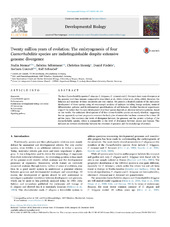Twenty million years of evolution: The embryogenesis of four Caenorhabditis species are indistinguishable despite extensive genome divergence
Memar, Nadin; Schiemann, Sabrina; Hennig, Christian; Findeis, Daniel; Conradt, Barbara; Schnabel, Ralf
Journal article, Peer reviewed
Published version

Åpne
Permanent lenke
https://hdl.handle.net/1956/21858Utgivelsesdato
2019-03-15Metadata
Vis full innførselSamlinger
Originalversjon
https://doi.org/10.1016/j.ydbio.2018.12.022Sammendrag
The four Caenorhabditis species C. elegans, C. briggsae, C. remanei and C. brenneri show more divergence at the genomic level than humans compared to mice (Stein et al., 2003; Cutter et al., 2006, 2008). However, the behavior and anatomy of these nematodes are very similar. We present a detailed analysis of the embryonic development of these species using 4D-microscopic analyses of embryos including lineage analysis, terminal differentiation patterns and bioinformatical quantifications of cell behavior. Further functional experiments support the notion that the early development of all four species depends on identical induction patterns. Based on our results, the embryonic development of all four Caenorhabditis species are nearly identical, suggesting that an apparently optimal program to construct the body plan of nematodes has been conserved for at least 20 million years. This contrasts the levels of divergence between the genomes and the protein orthologs of the Caenorhabditis species, which is comparable to the level of divergence between mouse and human. This indicates an intricate relationship between the structure of genomes and the morphology of animals.
